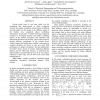Free Online Productivity Tools
i2Speak
i2Symbol
i2OCR
iTex2Img
iWeb2Print
iWeb2Shot
i2Type
iPdf2Split
iPdf2Merge
i2Bopomofo
i2Arabic
i2Style
i2Image
i2PDF
iLatex2Rtf
Sci2ools
ICASSP
2011
IEEE
2011
IEEE
Using clustering comparison measures for speaker recognition
Recent results seem to cast some doubt over the assumption that improvements in fused recognition accuracy for speaker recognition systems based on different acoustic features are due mainly to the different origins of the features (e.g. magnitude, phase, modulation information). In this study, we utilize clustering comparison measures to investigate acoustic and speaker modelling aspects of the speaker recognition task separately and demonstrate that front-end diversity can be achieved purely through different ‘partitioning’ of the acoustic space. Further, features that exhibit good ‘stability’ with respect to repeated clustering are shown to also give good EER performance in speaker recognition. This has implications for feature choice, fusion of systems employing different features, and for UBM data selection. A method for the latter problem is presented that gives up to an 11% relative reduction in EER using only 20-30% of the usual UBM training data set.
ICASSP 2011 | Signal Processing | Speaker Recognition | Speaker Recognition Systems | Speaker Recognition Task |
Related Content
| Added | 20 Aug 2011 |
| Updated | 20 Aug 2011 |
| Type | Journal |
| Year | 2011 |
| Where | ICASSP |
| Authors | Jia Min Karen Kua, Julien Epps, Mohaddeseh Nosratighods, Eliathamby Ambikairajah, Eric H. C. Choi |
Comments (0)

